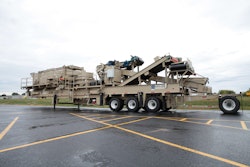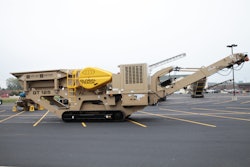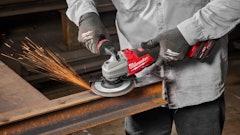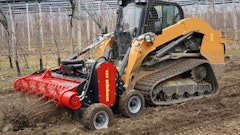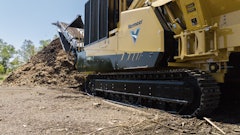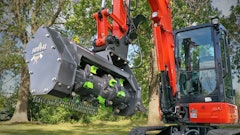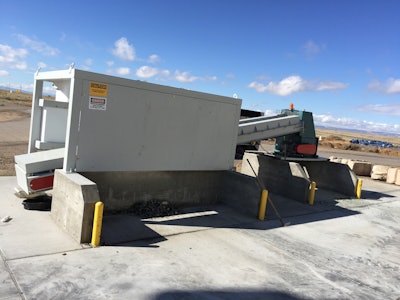
A community that works together can accomplish big things. And with initiatives like recycling programs, community involvement can determine success or failure.
The Village of Los Lunas has seen success firsthand with the community’s glass recycling efforts. The high level of resident participation, along with the help of a local glass crusher manufacturer, encouraged the Los Lunas recycling program to capitalize on glass diversion by finding opportunities to reuse and sell glass byproduct. It also helped the city expand the life of its landfill and progress on achieving its zero-waste goals.
Zero-waste Goals
All around the United States, recycling programs are striving to reach zero waste in the next 20 years. Zero waste initiatives involve diverting materials from landfills and transforming them into reusable products. The process protects the environment and natural resources.
“Our long-term plan is to divert as much as we possibly can out of the waste stream.
The more we can get out of the landfill, the better it is for everybody,” said Jason
Marquez, Los Lunas transfer station operator. “We are working to ensure that products are reused, repaired or recycled back into nature or the marketplace.”
Glass, alone, takes 1 million years to break down into its natural state. That’s one of the reasons the Los Lunas recycling program has taken such a proactive approach to glass recycling.
“Everybody wants to know why we care about glass. It costs us $33.66 per ton to bury any garbage or recyclable product in the landfill. Instead of paying to bury the glass, we can receive money by grinding and selling it. That’s a pretty good savings when you put the two together,” said Marcus Montoya, Los Lunas solid waste division director and recycling program supervisor. “As of the last calendar year we buried just under 11,000 tons of material at the landfill. That amount costs the Village of Los Lunas residents $340,000.
“Anything we can do to reduce that cost and the amount we bury is our priority,” Montoya said. To keep recyclables out of the landfill, the program needed to find a new way to use the glass. CEMCO, a local vertical shaft impact crusher and contract manufacturer, saw an opportunity for its technology to impact the local community. The company took its expertise and technology from rock crushing and applied it to glass to come up with a solution.
From Glass Gator to Glass Plant
Many Los Lunas residents were expressing interest in sustainability, so in 2008 the Los Lunas Recycling Program began hosting an annual recycling day. The event promoted sustainability in the community and asked residents to bring in paper, electronic equipment and other recyclables.
Jennifer Hise and Jerry Jackson of CEMCO both reside in Los Lunas. They saw the potential for the city to turn recycled glass into a sellable product. So they asked to attend the city’s recycling day event as a vendor and crush glass with CEMCO’s small crushing machine, the Glass Gator.
The Glass Gator works by taking in one bottle at a time and quickly crushing broken glass into fine, reusable cullets, a soft-edged sand byproduct that is safe to touch.
Once crushed, the glass is reusable for a variety of applications, such as landscaping and aggregate operations.
CEMCO continued to take the crushing unit to each recycling event and as awareness of glass collection and crushing grew, residents began bringing more and more glass. The program soon accumulated about 6,000 pounds of a glass in three years.
The city and residents were impressed with the machine’s performance and inspired by the potential of this new glass byproduct, and so the village decided to invest in a single unit in 2012. The city decided to use the Glass Gator to reduce its annual landfill costs and make a small income by selling crushed glass to local businesses.
Community members could bring in glass 24/7 to the drop-off collection site, and with about 700 to 800 residents from as far as 30 miles visiting the recycling facility each week, the amount of glass stockpiled started to outgrow the capacity of the Glass Gator.
The schedule for the glass crushing was set up for one Saturday each month for four hours. An operator would have to sort the glass into colors before crushing and load the Glass Gator by hand one bottle at a time. The time it was taking to accomplish crushing wasn’t keeping up with the amount of glass coming into the recycling center.
“In 2013, we took in 8.16 tons of glass from the residents. In 2014, we started crushing glass two Saturdays per month, and in that calendar year our annual report recorded a total of 13 tons of glass,” Montoya said. “The community responded in such a way that it was time to talk to CEMCO about a better and faster way to process glass.”
New Crusher in Town
While the Glass Gator was effective at crushing one bottle at a time for limited recycling capabilities, the increased demand meant that the division would need a larger machine that could process a minimum of 1 ton of glass per hour and be fed by conveyor rather than by hand. The Solid Waste Division team worked closely with CEMCO to design a larger machine that met the growing demand.
“CEMCO built the machine around our needs,” Marquez said. “They came in and evaluated our process, understood the efficiencies we wanted to achieve and designed a system that would easily fit into our operation without a lot of extra cost or modifications.”
CEMCO finalized the larger Glass Plant in February 2015. The horizontal rotary crusher includes a 4-cubic-yard hopper and a conveyor-fed crusher that has an integrated screen for sizing. The Glass Plant was installed in August 2015 and it runs two to three times a week for about an hour per day, crushing glass to a 3/8-inch size.
“In three months after installment, we’ve produced 9.54 tons of crushed glass with the new unit. By the end of the full calendar year, we will be well over 20 tons which will double the normal intake this first year,” Montoya said. “The increase positively impacts the city, residents and environment by extending the life of the landfill and reducing our landfill burying costs.”
Los Lunas’ zero waste initiative saved almost 150 cubic yards in the landfill in 2014.
And with more possibilities for glass diversion thanks to the CEMCO Glass Plant the team plans to save even more yardage in the landfill equating to over $14,290 in cost savings for reducing buried material.
The division will crush about 4 to 5 thousand pounds of glass per month. By the first full year the division’s goal is to crush a total of 36 to 40 tons and plans to continue increasing that amount going forward. Compared to the Glass Gator, the program can now process 1 ton of glass per week, quadrupling their monthly production.
In addition to reducing burying costs, the new glass plant has cut the city’s budget in other ways. With the Glass Plant’s implementation, the division cut overtime costs dramatically, by eliminating the need for workers to spend Saturdays feeding the Glass Gator.
“It used to take us all month to process that much glass on those few Saturdays. Now we use the new crusher for that same amount of glass and get it done within a half hour or so,” Marquez said.
The easy-to-operate-and-maintain machine reduces hand labor and saves about 176 hours of overtime a year, which can go toward completing other important Solid Waste Division projects within the village.
Version Diversion
So far, the Solid Waste Division recycles the crushed glass for a variety of applications, such as landscaping projects and for subsurface drainage around the recycling drop-off area. The division also maintains and seals their landfill, a year-round requirement by the State of New Mexico, by mixing clay soil, ground up glass and wood chippings to maintain the cap and help regenerate plant growth for a ground cover.
The Village of Los Lunas recently started working with a company called Growstone to turn the discarded glass into high-productivity, earth-friendly growing mediums and soil enhancers. Growstone takes glass and recycles it into customizable products ranging from substrates for advanced hydroponic growing systems to soil amendments that improve soil structure and texture. Growstone makes derivative products for applications in commercial and consumer uses. The division receives $8 per ton for delivering crushed glass to Growstone, turning what was once waste into a revenue generator.
If the recycling program produces its goal of 40 tons per year and Growstone purchases that tonnage, the recycling program would turn a $1,346 expense into a $320 profit.
When the Solid Waste Division doesn’t have to spend money to haul and bury glass
in the landfill, it sees the results in cost savings.
“As I said, for every ton we bury it costs $33.66. We saved about $440 by diverting
13 tons of glass and cutting overtime pay in 2014,” Montoya said. “This year, our projected savings is about $3,895 because of the return from our diversion efforts added with our savings on overtime hours.”
The savings from just a few thousand pounds of glass is making a positive impact to the Village’s bottom line budget and the division hopes the program will continue to grow and expand into other recycling efforts. Montoya says the overall savings will quickly pay off the total purchasing cost of the glass plant.
From mid-August to December the division has crushed over 46 tons of glass and has saved $5,450 on tipping fees. The division also saw a return of almost $400 from selling the crushed glass to equal a total savings of $5,850 in almost 4.5 months.
Looking Ahead
The Solid Waste Division continues working with the community to reach zero waste with glass recycling. At this time the recycling program only collects glass that is dropped off from the public at the recycling center, but looks forward to working with local businesses in the future.
“We want to begin collecting glass from the businesses within the community, especially those with an abundance of glass, such as restaurants and bars,” Montoya said. “We’re looking into whether our present structure could handle picking up from these customers.”
With a successful program in glass recycling, the Solid Waste Division is now eyeing media blasting, composting and metal recycling as other areas of focus.
“In the future we want to double the number of customers on our recycling collection route, add a processing plant and see curbside recycling,” said Joshua Chavez, Solid Waste Division recycle operator lead. “Our goal is to get as many people and local businesses involved in recycling as possible. We want to get as much as we can out of the waste stream.”
A Solid Plan
It takes a village to build a successful recycling program. The village of Los Lunas has found success through a strong community backing and is hopeful for the future.
As the city moves forward with glass recycling and new technology like the Glass
Plant, the recycling program will continue to improve on its mission to achieve zero-waste one step at a time.





